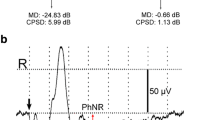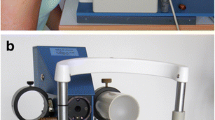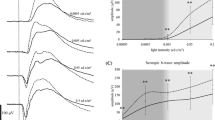Summary
Pieces of human retinas were dissected from dark adapted eyes enucleated because of malignant tumours. The preparations were perfused at 36°C with a glucose-containing ionic medium of pH 7.4. The rhodopsin content was determined by means of the absorbance changes due to bleaching. Electroretino-graphic responses were recorded transretinally.
Scotopicb-waves (8 preparations) or slow P III responses (19 preparations) were obtained at stimulus strengths corresponding to approx. one quantum absorbed per rod per flash (20 ms). Photopic potentials appeared when the stimuli were 1.5 log units more intense.
Partial bleaching of rhodopsin was followed by an amplitude decrease of scotopic responses. This decrease was a temporary one from which the retinas fully recovered if less than 6% of the rhodopsin had been bleached. Bleaching of larger amounts of the pigment resulted in a permanent loss of potential amplitude and of retinal sensitivity. During the recovery process after small bleaches, the reduction of potential amplitude was proportional to the concentration of metarhodopsin380 in the rods, and may indicate a link between metarhodopsin380 and the temporary desensitization of the retina.
Similar content being viewed by others
Literatur
Alpern, M.: Rhodopsin kinetics in the human eye. J. Physiol. (Lond.)217, 447–471.
Baumann, Ch.: Die Photosensitivität des Sehpurpurs in der isolierten Netzhaut. Vision Res.5, 425–434 (1965).
Baumann, Ch.: Sehpurpurbleichung und Stäbchenfunktion in der isolierten Froschnetzhaut. III. Die Dunkeladaptation des skotopischen Systems nach partieller Sehpurpurbleichung. Pflügers Arch. ges. Physiol.298, 70–81 (1967).
Baumann, Ch.: Flash photolysis of rhodopsin in the isolated frog retina. Vision Res.10, 789–798 (1970).
Baumann, Ch., Bender, S.: Kinetics of rhodopsin bleaching in the isolated human retina. J. Physiol. (Lond.) (zur Veröffentlichung eingereicht) (1973).
Bender, S., Baumann, Ch.: Kinetik der Sehpurpurbleichung in der isolierten menschlichen Netzhaut. Pflügers Arch.332 (Suppl.), R 92 (1972).
Dartnall, H. J. A.: The visual pigments. London: Methuen & Co., Ltd.; New York: John Wiley & Sons Inc. 1957.
Ernst, W., Kemp, C. M.: The effects of rhodopsin decomposition on PIII responses of isolated rat retinae. Vision Res.12, 1937–1946 (1972).
Hanitzsch, R., Byzov, A. L.: Methodische Voraussetzungen zur Ableitung mit Mikroelektroden an der isolierten menschlichen Netzhaut. Vision Res.3, 207–212 (1963).
Hanitzsch, R., Dettmar, P.: Das Elektroretinogramm der isolierten menschlichen Netzhaut bei Einzel- und Flimmerreizen und Potentialverläufe aus verschiedenen Netzhauttiefen. Docum. ophthal. (Den Haag)18, 412–418 (1964).
Hanitzsch, R., Hommer, K., Bornschein, H.: Der Nachweis langsamer Potentiale im menschlichen ERG. Vision Res.6, 245–250 (1966).
Lützow, A. v.: Die Bedeutung der Plasmafaktoren für die isolierte umströmte Kaninchennetzhaut. Experientia (Basel)22, 215–216 (1966).
Østerberg, G.: Topography of the layer of rods and cones in the human retina. Acta ophthal. (Kbh.), Suppl. 6 (1935).
Ripps, H., Weale, R. A.: Flash bleaching of rhodopsin in the human retina. J. Physiol. (Lond.)200, 151–159 (1969).
Rushton, W. A. H.: The difference spectrum and the photosensitivity of rhodopsin in the living human eye. J. Physiol. (Lond.)134, 11–29 (1956).
Rushton, W. A. H., Powell, D.: The early phase of dark adaptation. Vision Res.12, 1083–1093 (1972).
Sickel, W.: Stoffwechsel und Funktion der isolierten Netzhaut. In: R. Jung u. H. Kornhuber (Hrsg.): The Visual System: Neurophysiology and Psychophysics, pp. 80–94. Berlin-Göttingen-Heidelberg: Springer 1961.
Sickel, W.: Retinal metabolism in dark and light. In: Handbook of Sensory Physiology, Vol. VII/2 (M. G. F. Fuortes, Hrsg.), pp. 667–727. Berlin-Heidelberg-New York: Springer 1972.
Sickel, W., Lippmann, H.-G., Haschke, W., Baumann, Ch.: Elektrogramm der umströmten menschlichen Retina. Ber. dtsch. ophthal. Ges.63, 316–318 (1961).
Wald, G.: Human vision and the spectrum. Science101, 653–658 (1945).
Weinstein, G. W., Hobson, R. R., Dowling, J. E.: Light and dark adaptation in the isolated rat retina. Nature (Lond.)215, 134–138 (1967).
Author information
Authors and Affiliations
Rights and permissions
About this article
Cite this article
Bender, S., Baumann, C. Empfindlichkeit und Sehpurpurgehalt der isolierten menschlichen Netzhaut. Pflugers Arch. 341, 219–232 (1973). https://doi.org/10.1007/BF00592791
Received:
Issue Date:
DOI: https://doi.org/10.1007/BF00592791




